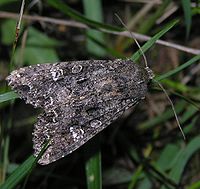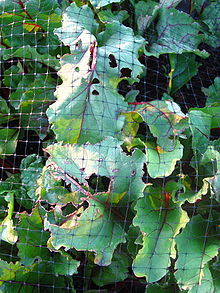- Cabbage Moth
-
Cabbage Moth 
Scientific classification Kingdom: Animalia Phylum: Arthropoda Class: Insecta Order: Lepidoptera Family: Noctuidae Genus: Mamestra Species: M. brassicae Binomial name Mamestra brassicae
(Linnaeus, 1758)Note: the Small White species of butterfly is commonly called a "cabbage moth" in North America.
The Cabbage Moth (Mamestra brassicae) is a common European moth of the family Noctuidae.
This species varies considerably in size, with a wingspan of 34–50 mm. The forewings are brown and mottled with a prominent white-edged stigma and a broken white sub terminal line.[1][2] The hind wings are grey, darker towards the termen. The prominent spur on the tibia of the foreleg is a diagnostic feature, though is best viewed with a magnifying lens. This moth has a rather complex life history: two or three broods are produced each year and adults can be seen at any time from May to October, occasionally at other times [1]. It flies at night and is attracted to light, sugar and nectar-rich flowers.
The larva is green, khaki, grey-brown or brown with dark spots.[1][2] The topside is darker than the bottom side and a yellow or light brown stripe goes round the middle portion by the spots.[1][2] They grow to about an inch long before pupating, As the common and scientific names suggest, it can be a pest of cultivated brassicas and sweet peas, but it feeds on a wide range of other plants (see list below).[2] Due to its complex life history, this species overwinters either as a larva or a pupa.
- ^ The flight season refers to the British Isles. This may vary in other parts of the range.
Recorded food plants
- Allium - Onion
- Aquilegia - Columbine
- Beta - Beet
- Brassica
- Bryonia - Bryony
- Calendula - Marigold
- Cannabis - Marijuana
- Chrysanthemum
- Cucurbita
- Dianthus - Carnation
- Helianthus - Sunflower
- Hyoscyamus - Henbane
- Hyssopus - Hyssop
- Lactuca - Lettuce
- Linum - Flax
- Lychnis - Maltese Cross
- Lycopersicon - Tomato
- Malus - Apple
- Nicotiana - Tobacco
- Pisum
- Plantago - Plantain
- Raphanus - Radish
- Rheum - Rhubarb
- Rudbeckia
- Rumex
- Silene
- Solanum - Potato
- Spinacia - Spinach
References
- ^ a b c "Interesting (To Us) Photos From The Garden". Meades.org. http://www.meades.org/photos_from_the_garden/garden_photos.html. Retrieved 2011-08-11.
- ^ a b c d "RXwildlife Sightings » Blog Archive » More Emergence". Rxwildlife.org.uk. 2009-06-03. http://rxwildlife.org.uk/2009/06/03/more-emergence/. Retrieved 2011-08-11.
- Chinery, Michael Collins Guide to the Insects of Britain and Western Europe 1986 (Reprinted 1991)
- Skinner, Bernard Colour Identification Guide to Moths of the British Isles 1984
Categories:- Mamestra
- Agricultural pest insects
- Invasive animal species
- Animals described in 1758
Wikimedia Foundation. 2010.


